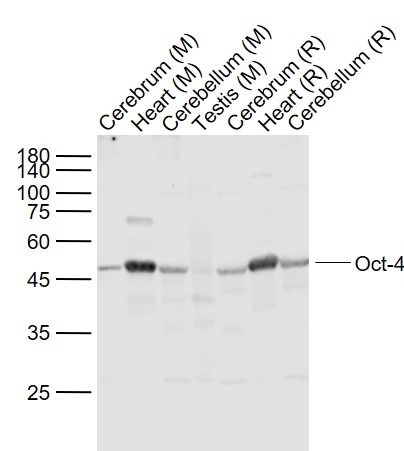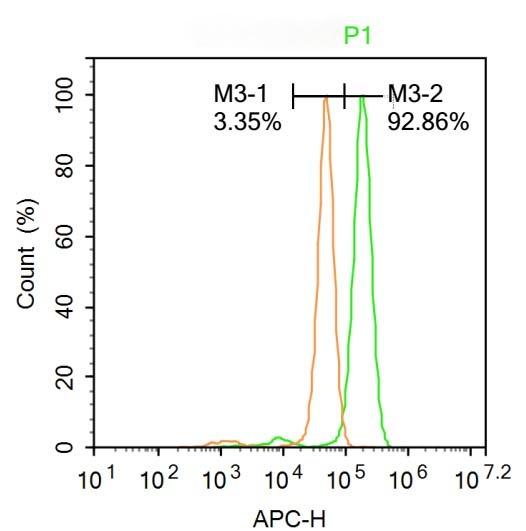Shopping Cart
- Remove All
 Your shopping cart is currently empty
Your shopping cart is currently empty
Anti-POU5F1 Polyclonal Antibody is a Rabbit antibody targeting POU5F1. Anti-POU5F1 Polyclonal Antibody can be used in FCM,WB.
| Pack Size | Price | Availability | Quantity |
|---|---|---|---|
| 50 μL | $221 | 7-10 days | |
| 100 μL | $373 | 7-10 days | |
| 200 μL | $528 | 7-10 days |
| Description | Anti-POU5F1 Polyclonal Antibody is a Rabbit antibody targeting POU5F1. Anti-POU5F1 Polyclonal Antibody can be used in FCM,WB. |
| Synonyms | transcription factor 1, POU5F1, POU domain, class 5, transcription factor 1, OTF3, Octamer-binding transcription factor 3 (OTF-3), Octamer-binding protein 4 (Oct-4), Octamer-binding protein 3 (Oct-3), class 5 |
| Ig Type | IgG |
| Reactivity | Human,Mouse,Rat (predicted:Dog,Pig,Cow) |
| Verified Activity | 1. Sample: Lane 1: Cerebrum (Mouse) Lysate at 40 μg Lane 2: Heart (Mouse) Lysate at 40 μg Lane 3: Cerebellum (Mouse) Lysate at 40 μg Lane 4: Testis (Mouse) Lysate at 40 μg Lane 5: Cerebrum (Rat) Lysate at 40 μg Lane 6: Heart (Rat) Lysate at 40 μg Lane 7: Cerebellum (Rat) Lysate at 40 μg Primary: Anti-Oct4 (TMAB-01562) at 1/1000 dilution Secondary: IRDye800CW Goat Anti-Rabbit IgG at 1/20000 dilution Predicted band size: 45 kDa Observed band size: 47 kDa 2. Blank control: Hela. Primary Antibody (green line): Rabbit Anti-4-Oct antibody (TMAB-01562) Dilution: 1 μg/10^6 cells; Isotype Control Antibody (orange line): Rabbit IgG. Secondary Antibody: Goat anti-rabbit IgG-AF647 Dilution: 1 μg/test. Protocol The cells were fixed with 4% PFA (10 min at room temperature) and then permeabilized with 90% ice-cold methanol for 20 min at room temperature. The cells were then incubated in 5% BSA to block non-specific protein-protein interactions for 30 min at-20°C. Cells stained with Primary Antibody for 30 min at room temperature. The secondary antibody used for 40 min at room temperature. 3. Blank control (Black line): Mouse spleen (Black). Primary Antibody (green line): Rabbit Anti-Oct4 antibody (TMAB-01562) Dilution: 3 μg/10^6 cells; Isotype Control Antibody (orange line): Rabbit IgG. Secondary Antibody (white blue line): Goat anti-rabbit IgG-PE Dilution: 1 μg/test. Protocol The cells were fixed with 4% PFA (10 min at room temperature) and then permeabilized with 90% ice-cold methanol for 20 min at room temperature. The cells were then incubated in 5% BSA goat serum to block non-specific protein-protein interactions for 15 min at room temperature. Cells stained with Primary Antibody for 30 min at room temperature. The secondary antibody used for 40 min at room temperature.    |
| Application | |
| Recommended Dose | WB: 1:500-2000; FCM: 1ug/Test |
| Antibody Type | Polyclonal |
| Host Species | Rabbit |
| Subcellular Localization | Nucleus.Note=Expressed in a diffuse and slightly punctuate pattern. |
| Tissue Specificity | Expressed in developing brain. Highest levels found in specific cell layers of the cortex, the olfactory bulb, the hippocampus and the cerebellum. Low levels of expression in adult tissues. |
| Construction | Polyclonal Antibody |
| Purification | Protein A purified |
| Appearance | Liquid |
| Formulation | 0.01M TBS (pH7.4) with 1% BSA, 0.02% Proclin300 and 50% Glycerol. |
| Concentration | 1 mg/mL |
| Research Background | This gene encodes a transcription factor containing a POU homeodomain. This transcription factor plays a role in embryonic development, especially during early embryogenesis, and it is necessary for embryonic stem cell pluripotency. A translocation of this gene with the Ewing's sarcoma gene, t(6;22)(p21;q12), has been linked to tumor formation. Alternative splicing, as well as usage of alternative translation initiation codons, results in multiple isoforms, one of which initiates at a non-AUG (CUG) start codon. Related pseudogenes have been identified on chromosomes 1, 3, 8, 10, and 12. [provided by RefSeq]. |
| Immunogen | KLH conjugated synthetic peptide: human OCT4 |
| Antigen Species | Human |
| Gene Name | POU5F1 |
| Gene ID | |
| Protein Name | POU domain, class 5, transcription factor 1 |
| Uniprot ID | |
| Biology Area | DNA / RNA binding,POU,Transcription Factors |
| Function | Transcription factor that binds to the octamer motif (5'-ATTTGCAT-3'). Forms a trimeric complex with SOX2 on DNA and controls the expression of a number of genes involved in embryonic development such as YES1, FGF4, UTF1 and ZFP206. Critical for early embryogenesis and for embryonic stem cell pluripotency. |
| Molecular Weight | Theoretical: 39 kDa. |
| Stability & Storage | Store at -20°C or -80°C for 12 months. Avoid repeated freeze-thaw cycles. |
| Transport | Shipping with blue ice. |

Copyright © 2015-2025 TargetMol Chemicals Inc. All Rights Reserved.